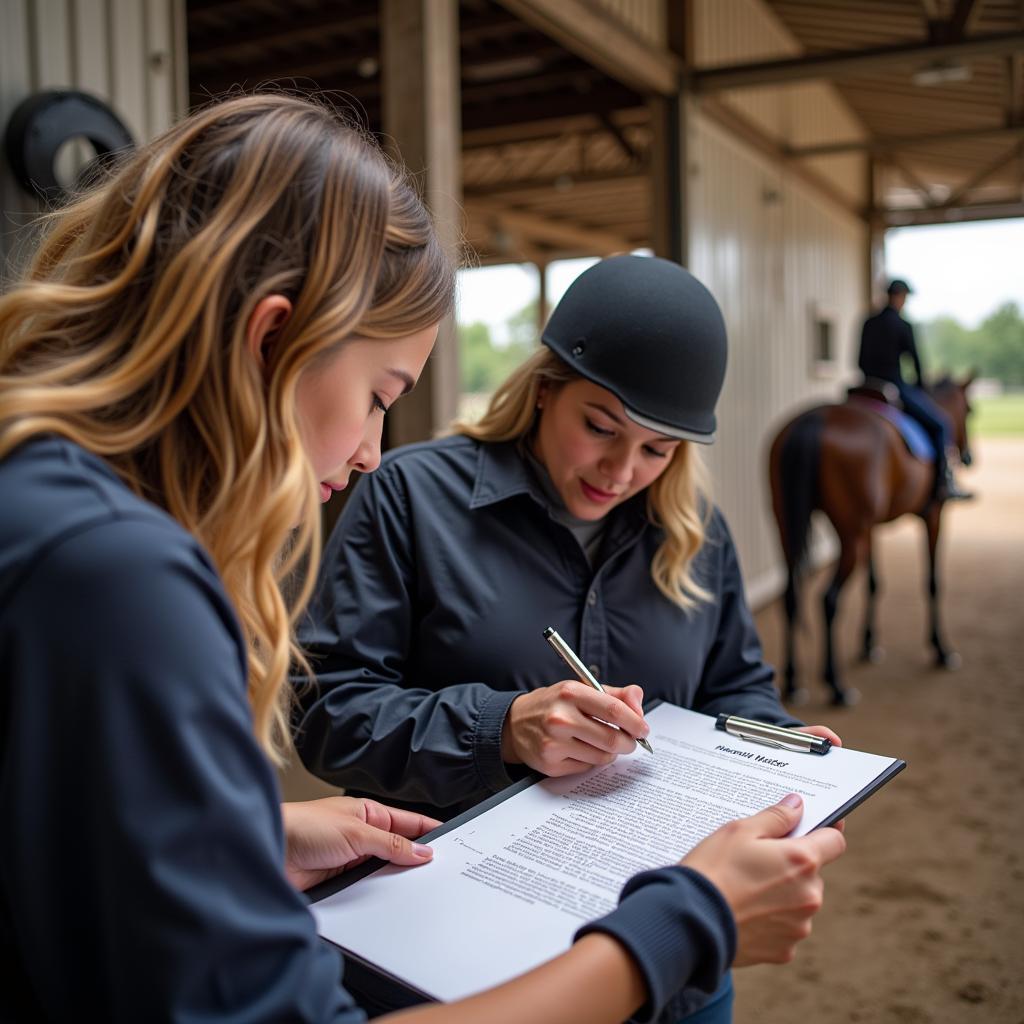A Horse Riding Waiver Of Liability Form is a crucial document for both horse businesses and riders. It protects the stable or riding facility from liability in case of accidents or injuries. Understanding this form is essential for anyone involved in equestrian activities. This article will explore the importance of waivers, what they typically cover, and why they are beneficial for all parties involved. Learn everything you need to know about the horse riding waiver of liability form.
What is a Horse Riding Liability Waiver?
A horse riding liability waiver, also known as a release of liability or indemnity agreement, is a legal document that a rider signs before participating in any horse-related activity. This form acknowledges the inherent risks associated with horseback riding and releases the stable, its owners, employees, and volunteers from liability in the event of an injury or accident. Essentially, the rider agrees not to sue the stable even if negligence on their part contributed to the incident. This doesn’t mean stables are exempt from gross negligence or intentional harm.
This form also protects horse boarding facilities, which are inherently risky environments. You can find more information on Knoxville horse boarding and horse boarding in Glendale AZ on our website. It’s critical to understand these waivers before engaging in any equestrian activities.
Why are Horse Riding Waivers Important?
Horse riding waivers are crucial for protecting horse businesses. Horses, despite their gentle nature, are large, powerful animals, and riding carries inherent risks. Even experienced riders can be injured. A waiver helps to mitigate these risks by ensuring that riders understand the potential dangers and accept responsibility for their own safety. It also helps to limit the financial exposure of the stable or riding facility in the event of a lawsuit.
Remember, a horse riding liability waiver doesn’t absolve stables from responsibility for ensuring a safe environment. It simply clarifies the inherent risks involved in the sport and confirms the rider’s understanding of those risks.
 Rider Signing a Horse Riding Waiver
Rider Signing a Horse Riding Waiver
What Does a Horse Riding Waiver Typically Cover?
Horse riding waivers vary in their specific wording, but they generally cover the following:
- Inherent Risks of Horseback Riding: This includes the unpredictable nature of horses, the possibility of being thrown or kicked, and the risks associated with riding on uneven terrain.
- Assumption of Risk: The rider acknowledges and accepts the inherent risks associated with horseback riding.
- Release of Liability: The rider agrees not to hold the stable, its owners, employees, or volunteers responsible for injuries or damages resulting from participation in horse-related activities.
- Medical Expenses: The waiver may state that the rider is responsible for their own medical expenses in case of injury.
- Rules and Regulations: The waiver may outline the rules and regulations of the stable, which the rider agrees to follow.
Understanding the specifics of a horse riding liability waiver is crucial before signing.
Key Elements of a Valid Waiver
For a waiver to be legally sound, it must meet specific criteria. It should be clearly written and easy to understand, avoiding complex legal jargon. The waiver must clearly state the risks involved and the rider’s agreement to assume those risks. It also needs to be signed voluntarily, without coercion or pressure. If a minor is riding, a parent or guardian must sign the waiver on their behalf. Furthermore, the waiver should comply with state and local laws.
What if I Don’t Understand the Waiver?
If you’re unsure about any aspect of the horse riding waiver, don’t hesitate to ask questions. It’s essential to fully understand the document before signing it. A reputable stable will be happy to explain the terms and answer any concerns you may have. If you’re still uncomfortable after discussing the waiver, you have the right to refuse to sign it. However, be aware that this may mean you cannot participate in the activity.
Protecting Yourself and the Stable
Understanding the horse riding liability waiver is vital for protecting both the rider and the stable. For riders, it ensures awareness of the risks involved. For horse businesses, it provides a crucial layer of legal protection.
For more information on horse businesses, visit our page on horse businesses.
 Safe Horse Riding Practices
Safe Horse Riding Practices
Conclusion
The horse riding waiver of liability form is a vital document in the equestrian world. It protects stables and riders by clearly outlining the inherent risks of riding and establishing a mutual understanding of responsibility. Before engaging in any horse-related activity, carefully review the waiver, ask questions, and ensure you understand its implications. This knowledge will contribute to a safer and more enjoyable riding experience for everyone involved. You can also learn more about different boarding options, such as a horse boarding stable.
FAQ
- What is a horse riding waiver? A legal document releasing a stable from liability in case of accidents.
- Why is it important? It protects both the rider and the stable by acknowledging the inherent risks of riding.
- What does it cover? Inherent risks, assumption of risk, release of liability, and sometimes medical expenses.
- What if I’m injured after signing a waiver? You’ve agreed not to sue the stable, but this doesn’t preclude gross negligence claims.
- Can I refuse to sign a waiver? Yes, but you may not be allowed to participate in the activity.
- Are waivers always enforceable? They are generally enforceable if clearly written and signed voluntarily.
- What if I don’t understand the waiver? Ask the stable staff to explain it; they should be happy to clarify.
For further assistance, please contact us at Phone: 0772127271, Email: [email protected], or visit us at QGM2+WX2, Vị Trung, Vị Thuỷ, Hậu Giang, Vietnam. We have a 24/7 customer service team available to help.